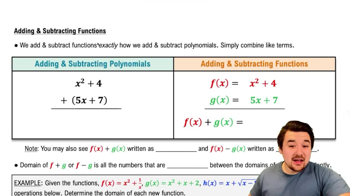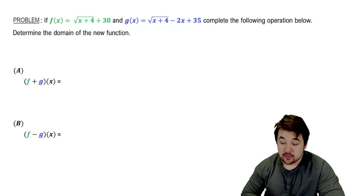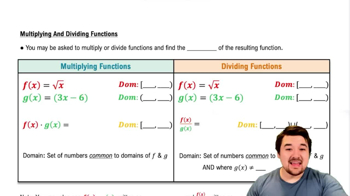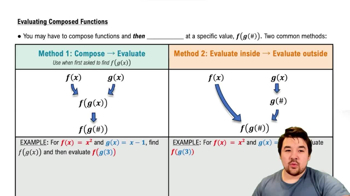Table of contents
- 0. Functions7h 52m
- Introduction to Functions16m
- Piecewise Functions10m
- Properties of Functions9m
- Common Functions1h 8m
- Transformations5m
- Combining Functions27m
- Exponent rules32m
- Exponential Functions28m
- Logarithmic Functions24m
- Properties of Logarithms34m
- Exponential & Logarithmic Equations35m
- Introduction to Trigonometric Functions38m
- Graphs of Trigonometric Functions44m
- Trigonometric Identities47m
- Inverse Trigonometric Functions48m
- 1. Limits and Continuity2h 2m
- 2. Intro to Derivatives1h 33m
- 3. Techniques of Differentiation3h 18m
- 4. Applications of Derivatives2h 38m
- 5. Graphical Applications of Derivatives6h 2m
- 6. Derivatives of Inverse, Exponential, & Logarithmic Functions2h 37m
- 7. Antiderivatives & Indefinite Integrals1h 26m
0. Functions
Combining Functions
Problem 3.1.63c
Textbook Question
Another way to approximate derivatives is to use the centered difference quotient: f' (a) ≈ f(a+h) - f(a- h) / 2h. Again, consider f(x) = √x.
c. Explain why it is not necessary to use negative values of h in the table of part (b).
 Verified step by step guidance
Verified step by step guidance1
Step 1: Understand the centered difference quotient formula: The centered difference quotient is given by \( f'(a) \approx \frac{f(a+h) - f(a-h)}{2h} \). This formula is used to approximate the derivative of a function at a point \( a \).
Step 2: Recognize the role of \( h \): In the formula, \( h \) is a small positive number that represents a small change in \( x \). The choice of \( h \) affects the accuracy of the approximation.
Step 3: Consider symmetry in the formula: The centered difference quotient uses both \( f(a+h) \) and \( f(a-h) \), which means it inherently considers both positive and negative changes around \( a \).
Step 4: Analyze the effect of negative \( h \): Using a negative \( h \) would simply reverse the roles of \( f(a+h) \) and \( f(a-h) \), but since the formula already accounts for both directions, negative values of \( h \) are redundant.
Step 5: Conclude on the necessity of negative \( h \): Since the centered difference quotient already incorporates both forward and backward differences through its symmetric structure, using negative values of \( h \) does not provide additional information or improve the approximation.
Recommended similar problem, with video answer:
 Verified Solution
Verified SolutionThis video solution was recommended by our tutors as helpful for the problem above
Video duration:
5mPlay a video:
Was this helpful?

 5:56m
5:56mWatch next
Master Adding & Subtracting Functions with a bite sized video explanation from Nick
Start learning




